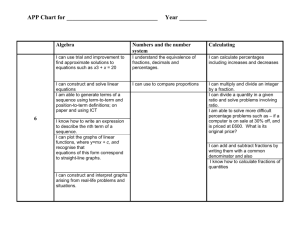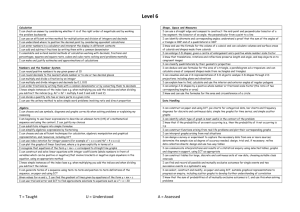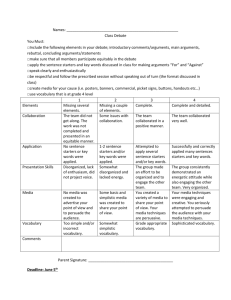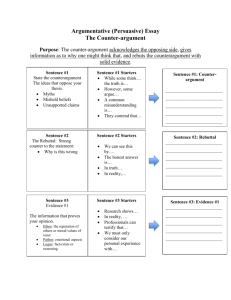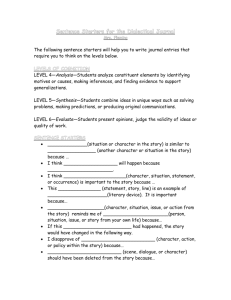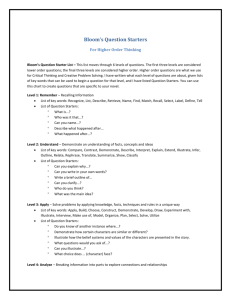Year 9 - Hertfordshire Grid for Learning
advertisement
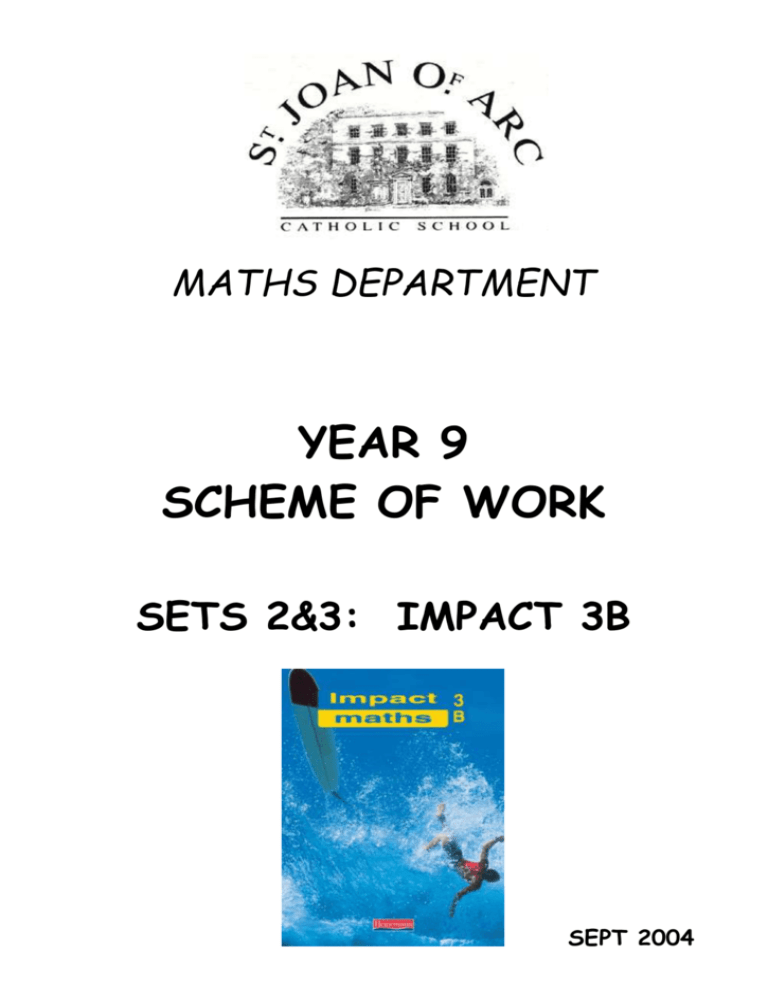
MATHS DEPARTMENT YEAR 9 SCHEME OF WORK SETS 2&3: IMPACT 3B SEPT 2004 3B PLAN AUTUMN TERM – FIRST HALF Topic 1 Positive & Negative Numbers Topic 2 Angles & Bearings Topic 3 Working with Algebra Topic 4 Averages Topic 5 Place Value + Number 3B Ch. 1 3B Ch. 2 3B Ch. 3 3B Ch. 4 Additional Unit + 3B Ch. 6 TEST 1 AUTUMN TERM – SECOND HALF Topic 6 Graphs Topic 7 Formulae & Equations Topic 8 Using a Calculator Topic 9 Fractions & Ratio Topic 10 Problem Solving 3B Ch. 5 3B Ch. 9 Additional Unit 3B Ch. 10 Additional Unit TEST 2 SPRING TERM – FIRST HALF Topic 11 Geometrical Reasoning Topic 12 Proportional Reasoning Topic 13 Decimals Topic 14 Number Patterns Additional Unit Additional Unit 3B Ch. 13 3B Ch. 12 TEST 3 SPRING TERM – SECOND HALF Topic 15 Handling Data + unit Topic 16 Perimeter, Area & Volume Topic 17 Percentages 3B Ch. 8 + Additional Unit 3B Ch. 15 3B Ch. 14 TEST 4 SUMMER TERM – FIRST HALF Topic 18 Probability Topic 19 Transformations Topic 20 Revision for SATs 3B Ch. 11 3B Ch. 7 CGP Packs & Past Papers SAT’s WEEK SUMMER TERM – SECOND HALF Start KS4 Intermediate Tier Scheme of Work immediately after SATs have taken place. AUTUMN TERM A Topic: Positive & Negative Numbers TOPIC 1 NC Level: 4 NC Programme of Study: Ref2a: Use previous understanding of integers and place value to deal with large positive numbers and round them to a given power of 10. Ref3a: Add and subtract integers. Learning Objectives: Order positive and negative numbers Use a horizontal number line Add, subtract, multiply and divide positive and negative numbers Key Vocabulary: ORDER POSITIVE NEGATIVE NUMBER LINE MINUS SIGN Impact Reference: Other references: Book 3B – ch.1 V5 – ch5 V8 – ch3 Mental & Oral Starters: 3B folder: pg. 4-6 101 Starters: pg. 19-23 Discussion opportunities: Pair / Group Work: Discuss where negative numbers occur in real Research which countries have the lowest life temperatures ICT Links: C4 Video “Walking Backwards” Spiritual/Moral/Citizenship Links: Positive qualities can balance out the negative Investigation: See above Time: 3-4 lessons AUTUMN TERM A Topic: Angles & Bearings TOPIC 2 NC Level: 5-7 NC Programme of Study: Ref2abc: Recall and use properties of angles at a point, on a straight line, perpendicular lines and opposite angles at a vertex. Distinguish between acute, obtuse, reflex and right angles; estimate the size in degrees. Use parallel line rules; understand properties of parallelograms and proof that the angle sum of a triangle is 180; understand proof that the exterior angle of a triangle is equal to the sum of the interior angles at the other 2 vertices. Ref3d: Recognise that enlargements preserve angle but not length; identify the scale factor of an enlargement as the ratio of the lengths of any corresponding line segments and apply this to triangles. Ref4bej: Understand angle measure using the associated language. Use straight edge and compasses to do standard constructions. Find loci, both by reasoning and by using ICT to produce shapes and paths. Learning Objectives: Solve problems using properties of angles, of parallel and intersecting lines Justify inferences and explain reasoning with diagrams and text Understand the proof that: - the sum of the angles of a triangle is 180 and of a quadrilateral is 360 - the exterior angle of a triangle is equal to the sum of the 2 interior opposite angles Explain how to find, calculate and use: - the sums of the interior & exterior angles of quadrilaterals, pentagons and hexagons - the interior and exterior angles of regular polygons Solve geometrical problems using side and angle properties of equilateral, isosceles and right-angled triangles and special quadrilaterals, explaining reasoning with diagrams and text Use straight edge and compasses to construct and then use ICT to explore these constructions: - the midpoint and perpendicular bisector of a line segment - the bisector of an angle - the perpendicular from a point to a line - the perpendicular from a point on a line Construct a triangle given 3 sides (SSS) Make simple scale drawings Distinguish between conventions, definitions and properties Give directions as three figure bearings Draw loci – the paths of points Key Vocabulary: ANGLE PARALLEL ALTERNATE SCALE DRAWING LOCUS LOCI CORRESPONDING CONSTRUCTION BEARINGS Other references: Booster L8 Impact Reference: Book 3B – ch.2 V5 – ch17, 19, 21 V6 – ch12-14 Mental & Oral Starters: 3B folder: pg. 24-28 101 Starters: pg. 73,74,80,82,83 Discussion opportunities: Pair / Group Work: Discuss angle rules, types of angles Proof work ICT Links: LOGO Spiritual/Moral/Citizenship Links: Everything has its own rules to follow – we need to be consistent Investigation: Derive angle rules Time: 6-7 lessons AUTUMN TERM A Topic: Working with Algebra TOPIC 3 NC Level: 5&6 NC Programme of Study: Ref5bc:Understand that the transformation of algebraic expressions obeys and generalises the rules of arithmetic; simplify or transform algebraic expressions by collecting like terms and by expanding the product of 2 linear expressions; distinguish in meaning between the words ‘equation’ ‘formula’ ‘identity’ ‘expression’. Use index notation for simple integer powers and simple instances of index laws; substitute positive and negative numbers into expressions. Learning Objectives: Simplify or transform linear expressions by collecting like terms; multiplying terms; multiply a single term over a bracket Simplify or transform algebraic expressions by taking out single-term common factors Use index notation for integer powers and simple instances of the index laws Expand and simplify double brackets Key Vocabulary: COLLECT SIMPLIFY LIKE TERMS BRACKETS EXPRESSION FACTORISE POWERS LINEAR Other references: Booster L6 Impact Reference: Book 3B – ch.3 V5 – ch9 V6 – ch7 V8 – ch6 Mental & Oral Starters: 3B folder: pg. 48-51 101 Starters: pg. 62-71 Discussion opportunities: Pair / Group Work: What do the variables represent? Algebraic ‘stories’ ICT Links: EXCEL can be used to substitute different values into different expressions. Spiritual/Moral/Citizenship Links: Variables can be used to represent real life objects or situations. Each letter can take many different values; symbolises different numbers – in life things change, objects symbolise significant meanings. Investigation: What happens as the variables change? Time: 5 lessons AUTUMN TERM A Topic: Averages TOPIC 4 NC Level: 4-6 NC Programme of Study: Ref4ab: Draw and produce pie charts for categorical data and diagrams for continuous data, including line graphs for time series, scatter graphs, frequency diagrams and stem-and-leaf diagrams. Calculate mean, range and median of small data sets with discrete then continuous data; identify the modal class for grouped data. Learning Objectives: Calculate statistics, including with a calculator Recognise when it is appropriate to use the range, mean, median and mode Find summary values that represent the raw data, and select the statistics most appropriate to the problem Find the mean and median from a frequency table Construct stem-and-leaf diagrams and use to find the median Key Vocabulary: MEAN MEDIAN MODE RANGE FREQUENCY TABLE STEM-AND-LEAF DIAGRAM Other references: Booster L14 Impact Reference: Book 3B – ch.4 V7 – ch19 Mental & Oral Starters: 3B folder: pg.68-69 101 Starters: pg. 96 Discussion opportunities: Pair / Group Work: What do the results mean? Collect class data ICT Links: EXCEL, data can be taken from the internet Spiritual/Moral/Citizenship Links: Data to be analysed should be taken from current issues Investigation: There is much scope here – try to keep it relevant to the students Time: 5 lessons AUTUMN TERM A Topic: Place Value TOPIC 5 NC Level: 5&6 Learning Objectives: Understand and use decimal notation and place value Multiply and divide integers and decimals by 10, 100, 1000 Explain the effects of the above multiplication and division Extend knowledge of integer powers of 10 Multiply and divide integers and decimals by 0.1, 0.01 etc. Additional Notes: Booster lesson 1 should be covered as a stand-alone lesson here Key Vocabulary: PLACE VALUE TENTHS HUNDREDTHS THOUSANDTHS EQUIVALENT POWER INDEX MULTIPLY DIVIDE Impact Reference: Other references: This links closely to ch.6 Booster lesson 1 Mental & Oral Starters: 101 Starters: pg. SEE LESSON PLAN 1 FOR DETAILED INFORMATION Time: 1 lesson AUTUMN TERM B Topic: Graphs TOPIC 6 NC Level: 5-7 NC Programme of Study: Ref6efgh: Use the conventions for co-ordinates in the plane; plot points in all 4 quadrants; recognise that equations of the form y=mx+c correspond to straight line graphs; plot graphs of functions in which y is given explicitly in terms of x. Construct linear functions arising from real life problems and plot their corresponding graphs; discuss and interpret graphs arising from real situations. Generate points and plot graphs of simple quadratic and cubic functions. Find the gradient of lines given by equations of the form y=mx+c; investigate the gradients of parallel lines and lines perpendicular to these lines. Ref4c (shape): Understand and use compound measures including speed and density. Learning Objectives: Plot the graphs of linear functions, where y is given explicitly in terms of x, on paper and using ICT Recognise that equations of the form y=mx+c correspond to straight line graphs Given values for m and c, find the gradient of lines given of the form y=mx+c Construct functions arising from real-life problems and plot their corresponding graphs Interpret graphs arising from real situations, including distance-time graphs Generate points and plot graphs of linear functions where y is given in terms of x – e.g. ay + bx = 0, y + bx + c = 0 Plot curves of quadratic functions Key Vocabulary: COORDINATE QUADRANT STRAIGHT LINE GRAPH INTERCEPT GRADIENT EQUATION CURVE QUADRATIC Impact Reference: Other references: Book 3B – ch.5 V5 – ch11 V6 – ch8-9 V7 – ch9-10 V8 – ch7 & 9 Mental & Oral Starters: 3B folder: pg. 86-88 101 Starters: pg. 72 Discussion opportunities: Pair / Group Work: Discuss the relationship between m and c in the Investigate the significance of m and c in equation y=mx+c y=mx+c ICT Links: Autograph, Omnigraph, graphical calculators. Outware: “Carpark” (Outware) Spiritual/Moral/Citizenship Links: Use graphs from current issues Investigation: See above Time: 8 lessons AUTUMN TERM B Topic: Formulae & Equations TOPIC 7 NC Level: 6&7 NC Programme of Study: Ref5defij: Understand that the transformation of algebraic expressions obeys and generalises the rules of arithmetic; simplify or transform algebraic expressions by collecting like terms and by expanding the product of 2 linear expressions; distinguish in meaning between the words ‘equation’ ‘formula’ ‘identity’ ‘expression’. Set up simple equations; solve simple equations by using inverse operations or by transforming both sides in the same way. Solve linear equations with integer coefficients in which the unknown appear on either side or on both sides of the equation; solve linear equations that require prior simplification of brackets. Use formulae from maths and other subjects; substitute numbers into formulae; derive a formula and change its subject. Solve simple linear inequalities in one variable and represent the solution on a number line. Learning Objectives: Know the meanings of the words ‘formula’ and ‘function’ Construct and solve linear equations with integer coefficients (unknown on either or both sides) using appropriate methods Use systematic trial and improvement methods and ICT tools to find approximate solutions of equations such as x3 + x = 20 Use formulae from maths and other subjects Substitute numbers into expressions and formulae Understand and use inequalities with integer values Solve inequalities using inverse methods Key Vocabulary: SUBSTITUTE WORD FORMULAE LINEAR EQUATION INEQUALITY TRIAL AND IMPROVEMENT Other references: Booster L13 Impact Reference: Book 3B – ch. 9 V5 – ch9-10 V6 – ch7 V7 – ch7 V8 – ch6 & 8 Mental & Oral Starters: 3B folder: pg. 212-215 101 Starters: pg. 62-71 Discussion opportunities: Pair / Group Work: Think of a situation that can be represented by Trial and improvement – estimate first and see a given formula who is closer ICT Links: EXCEL for trial and improvement C4 Video “Orders please” Spiritual/Moral/Citizenship Links: Real life situations can be represented by formulae. Investigation: What happens as the variables change? Time: 7-8 lessons AUTUMN TERM B Topic: TOPIC 8 Using a Calculator NC Level: Learning Objectives: Make and justify estimates and approximations of calculations Use a calculator efficiently and appropriately to perform complex calculations with numbers of any size Use sign change keys and function keys for powers, roots, brackets and memory Additional Notes: This should be used as a stand-alone lesson Key Vocabulary: ESTIMATE SIGNIFICANT CUBE FRACTION Impact Reference: UNITS DIGIT BRACKETS Other references: Booster lesson 4 SQUARE SQUARE ROOT Mental & Oral Starters: 101 Starters: pg. SEE LESSON PLAN 4 FOR DETAILED INFORMATION Time: 1 lesson AUTUMN TERM B Topic: Fractions & Ratio TOPIC 9 NC Level: 6&7 NC Programme of Study: Ref2cfg: Use fraction notation; understand equivalent fractions, simplifying a fraction by cancelling all common factors; order fractions by rewriting then with a common denominator. Use ratio notation, including reduction to its simplest form and its various links to fraction notation. Recognise where fractions are needed to compare proportions. Ref3cdln: : Calculate a given fraction of a given quantity, expressing the answer as a fraction; express a given number as a fraction of another; add and subtract fractions by writing them with a common denominator; perform short division to convert a simple fraction to a decimal. Understand and use unit fractions as multiplicative inverses; multiply and divide a given fraction by an integer, by a unit fraction and by a general fraction. Use efficient methods to calculate with fractions, including cancelling common factors before carrying out the calculation. Solve word problems including using informal strategies and the unitary method of solution. Learning Objectives: Add and subtract fractions by writing them with a common denominator Calculate fractions of quantities Multiply and divide an integer by a fraction Use efficient methods to add, subtract, multiply and divide fractions, interpreting division as a multiplicative inverse Cancel common factors before multiplying or dividing Reduce a ratio to its simplest form, including a ratio expressed in different units Divide a quantity into 2 or more parts in a given ratio Use the unitary method to solve simple word problems involving ratio and direct proportion Use proportional reasoning to solve a problem, choosing the correct number to take as 100% or as a whole Interpret and use ratio in a range of contexts, including solving word problems Key Vocabulary: MIXED NUMBER IMPROPER SIMPLIFY CANCEL RATIO PROPORTION SCALE LOWEST TERM Other references: Booster L5 & 15 Impact Reference: Book 3B – ch. 10 V5 – ch2-3 V6 – ch2 & 4 V8 – ch1 Mental & Oral Starters: 3B folder: pg. 234-238 101 Starters: pg. 36-38 Discussion opportunities: Pair / Group Work: Relationship between fractions and ratio Convert recipes Where are ratios used in life? ICT Links: C4 Video “Scaling the Heights” Spiritual/Moral/Citizenship Links: We are all made up of different ‘parts’ – e.g. creative, logical, academic, sporty – our ratios are all different Investigation: What happens to the ratio as the quantities change and vice versa? Time: 8 lessons AUTUMN TERM B Topic: Problem Solving TOPIC 10 NC Level: Learning Objectives: Identify the necessary information to solve a problem Solve more complex problems by breaking them down into smaller tasks/steps Interpret the numbers on a calculator display in different contexts Carry out more difficult calculations effectively and efficiently Solve problems and investigate in a range of contexts Explain and justify methods and conclusions Identify exceptional cases or counter-examples Additional Notes: Booster lessons 12 and 16 should be used as a stand-alone Problem Solving unit Key Vocabulary: EXPLAIN REASONS JUSTIFY Impact Reference: Other references: Booster lesson 12 & 16 Mental & Oral Starters: SEE LESSON PLAN 12 & 16 FOR DETAILED INFORMATION Time: 2 lessons SPRING TERM A Topic: TOPIC 11 Geometrical Reasoning Unit Learning Objectives: Distinguish between conventions, definitions and derived properties Distinguish between practical demonstration and proof; know underlying assumptions, recognising their importance and limitations, and the effect of varying them. Explain how to find, calculate and use: - the sums of the interior and exterior angles of quadrilaterals, pentagons and hexagons - the interior and exterior angles of regular polygons Solve problems using properties of angles, parallel and intersecting lines, and triangles and other polygons, justifying inferences and explaining reasoning with diagrams and text. Visualise and use 2D representation so of 3D objects; analyse 3D shapes through 2D projections, including plans and elevations Transform 2D shapes by combinations of translations and rotations Know that translations and rotations preserve length and angle and map objects on to congruent images Present a concise, reasoned argument, using symbols, diagrams and related explanatory text Give reasons for choice of presentation, explaining selected features and showing insight into the problem’s structure Suggest extensions to problems, conjecture and generalise Identify exceptional cases or counter examples, explaining why Justify generalisations, arguments or solutions Pose extra constraints and investigate whether particular cases can be generalised further. Additional Notes: Should be used as a stand-alone unit. Key Vocabulary: CONVENTION DEFINITION JUSTIFY DEDUCE GENERALISE PROVE VERTICALLY OPPOSITE ALTERNATE CORRESPONDING INTERIOR EXTERIOR SUPPLEMENTARY PLAN ELEVATION PROJECTION Impact Reference: Other references: Ch.2 Year 9 Geometrical Reasoning mini-pack SEE MINI-PACK FOR FURTHER GUIDANCE Time: 6-7 lessons PROOF SPRING TERM A Topic: TOPIC 12 Proportional Reasoning Unit Learning Objectives: Understand the effects of multiplying and dividing numbers between 0 and 1 Use the laws of arithmetic and inverse operation Recognise and use reciprocals Enter numbers into a calculator and interpret the display in context Recognise when fractions or percentages are needed to compare proportions Solve problems involving percentage changes Use proportional reasoning to solve a problem, choosing the correct numbers to take as 100% or as a whole Understand and use proportionality and calculate the result of any proportional change using multiplicative methods Understand the implications of enlargement for area and volume Compare 2 ratios Interpret and use ratio in a range of contexts, including solving word problems Enlarge 2D shapes; recognise the similarity of the resulting shapes; identify the scale factor of an enlargement as the ratio of the lengths of any 2 corresponding line segments; recognise that enlargements preserve angle but not length Solve increasingly demanding problems and evaluate solutions Explore connections in maths across a range of contexts Represent problems and synthesise information in algebraic, geometric or graphical form Suggest extensions to problems, conjecture and generalise Identify exceptional cases or counter-examples, explaining why Justify generalisations, arguments or solutions Pose extra constraints and investigate whether particular cases can be generalised further Additional Notes: Should be used as a stand-alone unit. Can relate back to topic 9 Key Vocabulary: SCALE MULTIPLIER INVERSE OPERATION RECIPROCAL RATIO PROPORTION RATE UNITARY ENLARGE CENTRE SIMILAR Impact Reference: Other references: Ch.10 Year 9 Proportional Reasoning mini-pack SEE MINI-PACK FOR FURTHER GUIDANCE Time: 9 lessons SPRING TERM A Topic: Decimals TOPIC 13 NC Level: 4-7 NC Programme of Study: Ref2d: Use decimal notation and recognise that each terminating decimal is a fraction. Ref3achijk:Add, subtract, multiply and divide integers and then any number; multiply a number by a number between 0 and 1. Perform short division to convert a simple fraction to a decimal. Round to the nearest integer and to 1 sig fig; estimate answers to problems involving decimals. Add and subtract mentally numbers with up to 2 decimal places; multiply and divide numbers with no more than 1 decimal digit. Use standard column procedures and understand where to position the decimal point. Learning Objectives: Recall known facts, including fraction to decimal conversions Extend mental methods of calculation, working with decimals, fractions, percentages, factors, powers and roots Make and justify estimates and approximations of calculations Round positive numbers and decimals to the nearest whole number and to 1 or 2 decimal places Multiply and divide integers and decimals by 0.1, 0.01 Use rounding to make estimates Know that a recurring decimal is an exact fraction Use standard column procedures to add and subtract integers and decimals of any size, including a mixture of large and small numbers with differing numbers of decimal places Use standard column procedures for multiplication and division of integers and decimals, including decimals such as 0.6 and 0.06 Multiply and divide by decimals, dividing by transforming to division by an integer Understand where to position the decimal point by considering equivalent calculations Key Vocabulary: ORDER PLACE VALUE CONVERT EQUIVALENT ROUND DECIMAL PLACE SIGNIFICANT FIGURE ESTIMATE Impact Reference: Other references: Book 3B – ch. 13 V6 – ch2 V7 – ch2 Mental & Oral Starters: 3B folder: pg. 292-295 101 Starters: pg. 46,52.53 Discussion opportunities: Pair / Group Work: Discuss methods Why do we round numbers? ICT Links: Spiritual/Moral/Citizenship Links: Significance – the numbers after the decimal point are equally as important as the numbers before the point – we are all equally significant Investigation: When do we use decimals/rounding in real life? Time: 6-8 lessons SPRING TERM A Topic: Number Patterns TOPIC 14 NC Level: 5&6 NC Programme of Study: Ref6ab: Generate common integer sequences. Find the first terms of a sequence given a rule arising naturally from a context; find the rule for the nth term of a sequence. Generate terms of a sequence using term-to-term and position-to-term definitions of the sequence; use linear expressions to describe the nth term of an arithmetic sequence, justifying its form by referring to the activity or context from which it was generated. Learning Objectives: Generate and describe integer sequences Generate terms of a sequence using term-to-term and position-to-term definitions of the sequence, on paper and using ICT Generate sequences from practical contexts and write an expression to describe the nth term of an arithmetic sequence Use differencing to find the general rule Find the inverse of a linear function Key Vocabulary: NUMBER MACHINES SEQUENCES nth TERM DIFFERENCE GENERAL RULE Other references: Booster L7 Impact Reference: Book 3B – ch.12 V5 – ch8 V6 – ch6 V7 – ch5 Mental & Oral Starters: 3B folder: pg. 274-275 Discussion opportunities: Pair / Group Work: The rules for the next value Create sequences and rules ICT Links: EXCEL Spiritual/Moral/Citizenship Links: Patterns / sequences that occur in nature. The terms follow the same rule – like the rules we all have to follow in school/life Investigation: Sequences that occur in real life Time: 4-5 lessons SPRING TERM B Topic: Handling Data TOPIC 15 NC Level: 5-7 NC Programme of Study: Ref3a: Design and use data collection sheets for grouped discrete and continuous data; collect data using various methods including observation, controlled experiment, data logging, questionnaires and surveys. Ref4a: Draw and produce using paper and ICT, pie charts for categorical data and diagrams for continuous data including scatter graphs, frequency diagrams and stem-and-leaf diagrams. Ref5g:Use lines of best fit Learning Objectives: Decide which data to collect to answer a questions, and the degree of accuracy needed Design a survey or experiment to capture the necessary data from one or more sources Determine the sample size and degree of accuracy needed Collect data using a suitable method, such as observation, controlled experiment, including data logging using ICT, or questionnaire Construct on paper and using ICT: - pie charts for categorical data - bar charts and frequency diagrams for discrete data Identify which are most useful in the context of the problem Interpret tables, graphs and diagrams for discreet data and draw inferences that relate to the problem being discussed Select, construct and modify, on paper and using ICT, suitable graphical representation to progress an enquiry including line graphs for time series Identify key features present in the data Interpret graphs and diagrams and draw inferences to support or cast doubt on initial conjectures Have a basic understanding of correlation Key Vocabulary: QUESTIONNAIRE TALLY BAR CHART PICTOGRAM PIE CHART SCATTER DIAGRAM LINE OF BETS FIT HISTOGRAM FREQUENCY POLYGON Other references: Booster L14 Impact Reference: Book 3B – ch. 8 V5 – ch24-26 V6 – ch18-19 V7 – ch18-20 V8 – ch17 Mental & Oral Starters: 3B folder: pg. 170-173 101 Starters: pg. 98 Discussion opportunities: Pair / Group Work: It is very important to discuss which method of Collect information and select how best to presentation is most appropriate and to compare present it. different sets of results. INFERENCES ICT Links: EXCEL, Autograph (Statistics) Spiritual/Moral/Citizenship Links: Use data from current issues – draw inferences Investigation: There is plenty of scope here Time: 7-8 lessons ADDITIONAL UNIT Topic: Handling Data NC Level: Learning Objectives: Find the mode, median, mean and range Interpret graphs, diagrams and tables for discrete and continuous data Draw inferences that relate to the problem being discussed Relate summarised data to the questions being explored Compare two distributions using the range and one or more of the mode, median and mean Additional Notes: This should be used alongside chapter 9 Key Vocabulary: MODE MEDIAN MEAN RANGE COMPARE SLIGHTLY SIGNIFICANTLY Impact Reference: Other references: This links closely to ch.8 Booster lesson 14 Mental & Oral Starters: GREATER LESS SEE LESSON PLAN 14 FOR DETAILED INFORMATION Time: 1 lesson SPRING TERM B TOPIC 16 Topic: Perimeter, Area & Volume NC Level: 4-7 NC Programme of Study: Ref4fgh: Find areas of rectangles, recalling the formula, understanding the connection to counting squares and how it extends this approach; recall and use the formulae for the area of a parallelogram and a triangle; find the surface area and perimeter of simple shapes. Find volumes of cuboids; calculate volumes of right prisms and of shapes made from cubes and cuboids. Find circumferences of circles and areas enclosed by circles, recalling relevant formulae. Learning Objectives: Use units of measurement to calculate, estimate, measure and solve problems in a variety of contexts Deduce and use formulae for the area of a triangle, parallelogram and trapezium Calculate areas of compound shapes made from rectangles and triangles Know and use the formulae for the circumference and area of a circle Know and use the formula for the volume of a cuboid Calculate volumes and surface areas of cuboids and shapes made from cuboids Calculate the surface area and volume of right prisms Key Vocabulary: PERIMETER AREA VOLUME LENGTH WIDTH HEIGHT PERPENDICULAR COMPOSITE CIRCUMFERENCE Other references: Booster L9 & 10 Impact Reference: Book 3B – ch. 15 V6 – ch11 V7 – ch15 Mental & Oral Starters: 3B folder: pg. 322-325 101 Starters: pg.94,95 Discussion opportunities: Pair / Group Work: Estimations Derive formulae for circle/surface areas ICT Links: Spiritual/Moral/Citizenship Links: Areas that occur in real life Investigation: The Fencing Problem Time: 6-7 lessons SPRING TERM B Topic: Percentages TOPIC 17 NC Level: 5&6 NC Programme of Study: Ref3em: Convert simple fractions of a whole to percentages of the whole and vice versa, then understand the multiplicative nature of percentages as operators. Solve simple percentage problems, including increase and decrease. Learning Objectives: Interpret percentage as the operator ‘so many hundredths of’ Express one given number as a percentage of another Recognise when fractions or percentages are needed to compare proportions Solve problems involving percentage change – inc. profit, loss, VAT, hire purchase, simple interest Converting between fractions, decimals and percentages Key Vocabulary: CONVERT AMOUNT INCREASE DECREASE COMPARE PROFIT LOSS TAX CREDIT SIMPLE INTEREST Other references: Booster L2 & 3 Impact Reference: Book 3B – ch. 14 V5 – ch2 V6 – ch3 Mental & Oral Starters: 3B folder: pg. 308-311 101 Starters: pg. 38,54 Discussion opportunities: Pair / Group Work: Conversions between fractions, decimals, Investigate interest rates – bank accounts percentages. ICT Links: C4 Video “Not all there” Spiritual/Moral/Citizenship Links: Tax, interest rates, the Budget Investigation: As above Time: 6-7 lessons SUMMER TERM A Topic: Probability TOPIC 18 NC Level: 5-7 NC Programme of Study: Ref4def: Understand and use the probability scale. Understand and use estimates or measures of probability from theoretical models, including equally likely outcomes, or from relative frequency. List all outcomes for single events and for 2 successive events in a systematic way. Identify different mutually exclusive outcomes and know that the sum of the probabilities of these outcomes is 1. Ref5i: Compare experimental data and theoretical probabilities. Learning Objectives: Use the vocabulary of probability in interpreting results involving uncertainty and prediction Know that is the probability of an event occurring is p, then the probability of it not occurring is 1-p Find and record all possible mutually exclusive outcomes for combined events using diagrams and tables Identify all mutually exclusive outcomes of an experiment Know that the sum of probabilities of all mutually exclusive outcomes is 1, and use this when solving problems Estimate probabilities from experimental data Understand that if an experiment is repeated, there may be, and usually will be, different outcomes Compare experimental and theoretical probabilities in a range of contexts Key Vocabulary: EXPERIMENTAL THEORETICAL EXPECTED NUMBER POSSIBILITY SPACE EVENT Other references: Booster L11 Impact Reference: Book 3B – ch. 11 V5 – ch28-29 V6 – ch20 V7 – ch22-23 V8 – ch19 Mental & Oral Starters: 3B folder: pg. 254-256 101 Starters: pg. 99-101 Discussion opportunities: Pair / Group Work: Discuss the probability of real life events Experimental probability occurring ICT Links: Random number generators Spiritual/Moral/Citizenship Links: Probability of real life events; gambling; the lottery Investigation: Experimental probability of class data Time: 5-6 lessons SUMMER TERM A Topic: Transformations TOPIC 19 NC Level: 4-7 NC Programme of Study: Ref2dk: Use angle properties of triangles; understand congruence, recognising when 2 triangles are congruent. Use 2D representation of 3D shapes and analyse 3D shapes through 2D projections and cross-sections, including plan and elevation. Ref3abc: Understand that rotation are specified by a centre and an angle; use right angles, fractions of turn or degrees to measure the angle of rotation; understand that reflections are specified by a mirror line, translations by a distance and direction, and enlargements by a centre and positive scale factor. Recognise and visualise rotations, reflections and translations; recognise that these transformations preserve length and angle. Learning Objectives: Understand congruence Transform 2D shapes by combinations of translations, rotations and reflections, on paper and using ICT Know that translations, rotations and reflections preserve length and angle and map objects on to congruent images Understand and use the language and notation associated with enlargement Enlarge 2D shapes given a centre of enlargement and a whole number scale factor, on paper and using ICT Identify the scale factor of an enlargement as the ratio of the lengths of any 2 corresponding line segments Use and interpret maps and scale drawings Key Vocabulary: REFLECTION ROTATION TRANSLATION ENLARGEMENT CONGRUENCE TESSELLATION PLAN ELEVATION Impact Reference: Other references: Book 3B – ch. 7 V6 – ch16 V7 – ch16 Mental & Oral Starters: 3B folder: pg. 132-135 101 Starters: pg. 87-89 Discussion opportunities: Pair / Group Work: Identify the transformations that have taken place ICT Links: LOGO. OHT’s are very useful here. “Carpark” (Outware) Spiritual/Moral/Citizenship Links: People can be transformed or reformed Investigation: Does the order of transformations matter? Time: 7-8 lessons Time should now be spent revising for the SATs exams – use past papers and CGP packs. After the SATs, the KS4 Intermediate Tier Scheme of Work should be started.
